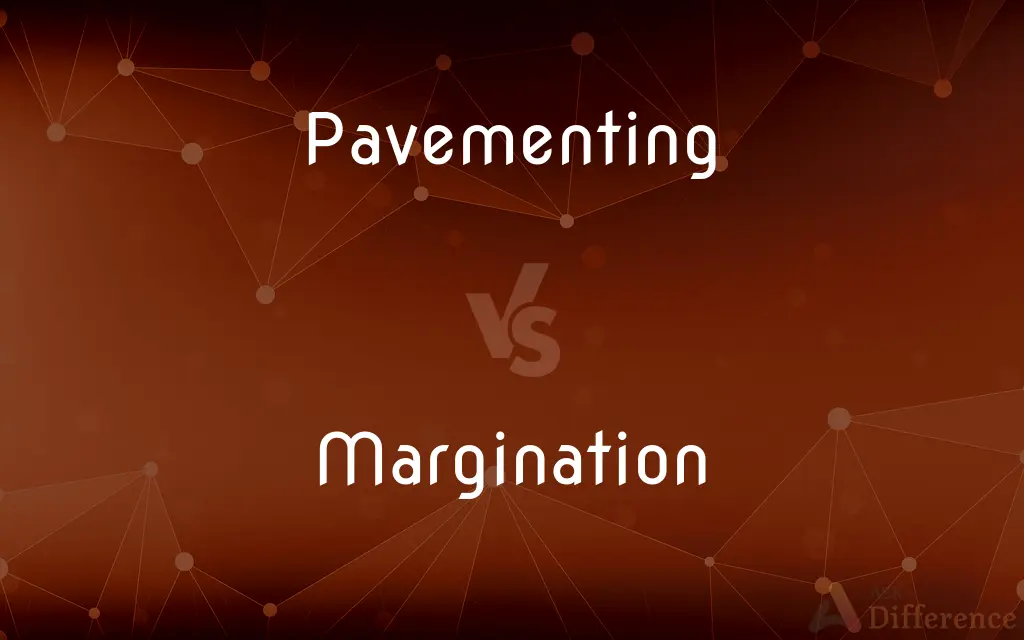Pavementing vs. Margination — What's the Difference?
By Maham Liaqat & Fiza Rafique — Updated on March 24, 2024
Pavementing involves white blood cells lining vessel walls, whereas margination is their movement to the periphery in blood flow.

Difference Between Pavementing and Margination
Table of Contents
ADVERTISEMENT
Key Differences
Pavementing refers to the process where leukocytes (white blood cells) adhere to the endothelial cells lining the blood vessel walls. This phenomenon is crucial in the body's inflammatory response, allowing leukocytes to position themselves for potential migration through the vessel wall to reach affected tissues. Margination, on the other hand, describes the movement and accumulation of leukocytes to the periphery of blood flow within vessels, a preliminary step before pavementing occurs.
During an inflammatory response, blood flow dynamics change, causing leukocytes to move to the sides of blood vessels in a process known as margination. This is facilitated by the reduced flow rate and increased viscosity of blood near the vessel walls. Following margination, leukocytes undergo pavementing, where they form strong adhesions with endothelial cells, a critical step before they can exit the bloodstream to attend to sites of infection or injury.
The adhesion molecules involved in pavementing, such as selectins and integrins, play a key role in the firm attachment of leukocytes to the endothelium. Margination, however, is more influenced by hemodynamic factors and the interaction of leukocytes with plasma proteins, which help in positioning the leukocytes closer to the vessel walls.
In terms of their role in the immune response, pavementing is directly involved in the process of leukocyte extravasation, where leukocytes exit the bloodstream. Margination, while not directly involved in extravasation, is essential for positioning leukocytes in a way that they can engage in pavementing and subsequent transmigration.
Pavementing and margination, though distinct processes, are interconnected stages of the leukocyte adhesion cascade, a series of events that enable leukocytes to reach sites of tissue damage or infection efficiently. The effective coordination of these processes is vital for a robust and timely immune response.
ADVERTISEMENT
Comparison Chart
Definition
Adhesion of leukocytes to vessel walls.
Movement of leukocytes to vessel periphery.
Role in Immune Response
Prepares leukocytes for extravasation.
Positions leukocytes for pavementing.
Influencing Factors
Adhesion molecules (selectins, integrins).
Hemodynamics, interaction with plasma proteins.
Sequence in Immune Response
Follows margination.
Precedes pavementing.
Key Purpose
Facilitate leukocyte transmigration.
Enable leukocyte accumulation near vessel walls.
Compare with Definitions
Pavementing
The adhesion of leukocytes to endothelial cells.
Pavementing is observed when white blood cells cling to the inner walls of blood vessels.
Margination
The migration of leukocytes to the periphery of blood flow.
Margination is the first step in the leukocyte adhesion cascade.
Pavementing
A crucial step in the immune response allowing leukocytes to reach inflamed tissues.
The process of pavementing ensures that leukocytes are ready to respond to an infection site.
Margination
Influenced by blood flow and vessel architecture.
Slower blood flow in capillaries facilitates the margination of leukocytes.
Pavementing
Facilitated by specific adhesion molecules on leukocytes and endothelial cells.
Selectins play a significant role in the pavementing of leukocytes during inflammation.
Margination
A precursor to leukocyte adhesion and transmigration.
Following margination, leukocytes undergo firm adhesion to the vessel wall.
Pavementing
Often observed in microcirculation during acute inflammatory responses.
Microscopic examination reveals pavementing of leukocytes in capillaries during acute inflammation.
Margination
Enhances the efficiency of the immune surveillance system.
Margination helps in the rapid deployment of leukocytes to areas of infection.
Pavementing
Indicates a high level of leukocyte activation.
Increased pavementing of leukocytes is a marker of systemic inflammation.
Margination
Visible in blood vessels during the early stages of inflammation.
Margination of leukocytes can be seen in venular segments during the onset of inflammation.
Pavementing
(pathology) The situation where damaged endothelium undergoes a change in properties that allows leukocytes to adhere to it.
Margination
To provide with or be a margin to; border.
Margination
To add margin to (a stock portfolio).
Margination
(Biology) Having a distinct border or edge.
Margination
The provision of margins
Margination
(biology) extravasation of leukocytes to a site of tissue damage
Common Curiosities
How do changes in blood flow affect margination?
Changes in blood flow, such as reduced velocity in inflamed areas, enhance margination by allowing leukocytes to move out of the central blood stream and accumulate near the vessel walls.
What are the main molecules involved in pavementing?
The main molecules involved in pavementing include selectins and integrins, which mediate the firm adhesion of leukocytes to endothelial cells.
Can pavementing occur without margination?
Pavementing typically follows margination, as margination positions leukocytes near the vessel walls, a necessary step before they can adhere to the endothelium.
What triggers pavementing in blood vessels?
Pavementing is triggered by inflammatory signals that increase the expression of adhesion molecules on leukocytes and endothelial cells.
What role does the endothelium play in margination?
The endothelium influences margination by altering vascular permeability and expressing molecules that can interact with leukocytes, facilitating their movement to the vessel periphery.
Is margination affected by blood viscosity?
Yes, increased blood viscosity can enhance margination by slowing down blood flow and promoting the radial migration of leukocytes towards the vessel walls.
Why is margination important in the immune response?
Margination is important because it positions leukocytes closer to the vessel walls, making them ready for subsequent adhesion and transmigration to affected tissues.
Can pavementing lead to tissue damage?
While pavementing is crucial for immune response, excessive or inappropriate leukocyte adhesion can contribute to tissue damage in chronic inflammation or autoimmune diseases.
How is margination observed?
Margination can be observed under a microscope in blood vessels, particularly in areas of slow blood flow or inflammation, where leukocytes accumulate along the vessel periphery.
Does pavementing occur in all types of blood vessels?
Pavementing primarily occurs in smaller blood vessels, such as capillaries and venules, where leukocytes can closely interact with the endothelial lining.
What factors can disrupt margination?
Factors like high blood flow rates, reduced leukocyte count, or altered endothelial function can disrupt the normal process of margination.
How does the immune system regulate pavementing?
The immune system regulates pavementing through various signaling molecules like cytokines, which modulate the expression of adhesion molecules involved in leukocyte adhesion.
How does pavementing facilitate leukocyte extravasation?
Pavementing stabilizes leukocytes against the vessel walls, allowing them to respond to chemotactic signals that guide them through the endothelial layer to the site of injury or infection.
Share Your Discovery

Previous Comparison
Perfective vs. Perfect
Next Comparison
Pomp vs. PageantryAuthor Spotlight
Written by
Maham LiaqatCo-written by
Fiza RafiqueFiza Rafique is a skilled content writer at AskDifference.com, where she meticulously refines and enhances written pieces. Drawing from her vast editorial expertise, Fiza ensures clarity, accuracy, and precision in every article. Passionate about language, she continually seeks to elevate the quality of content for readers worldwide.














































